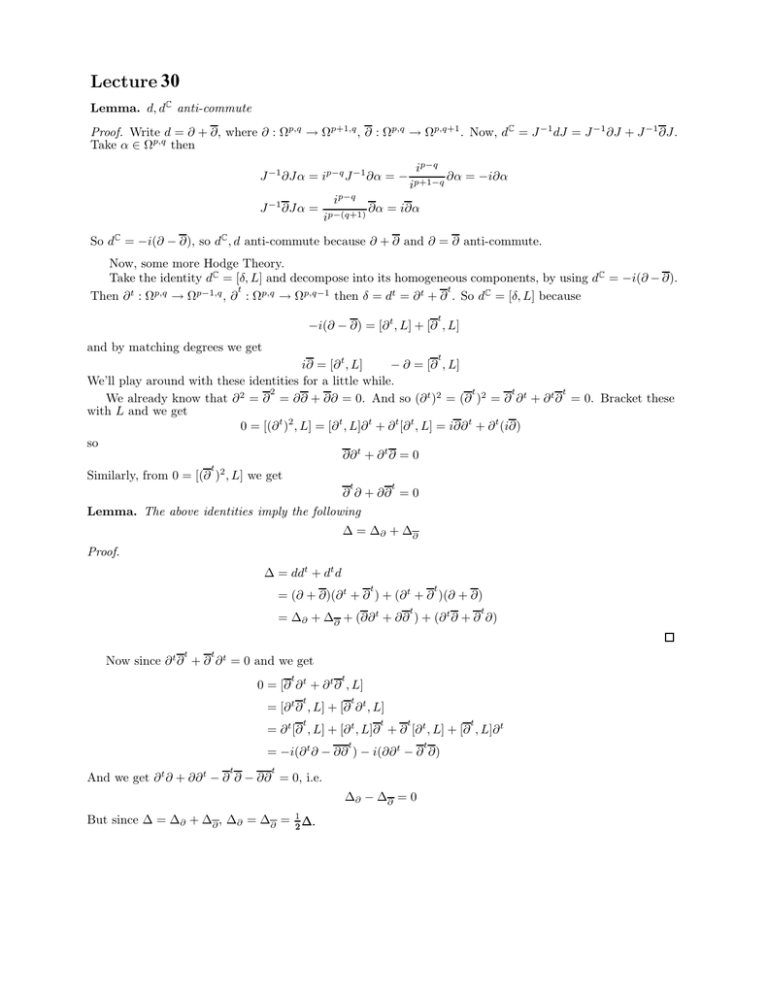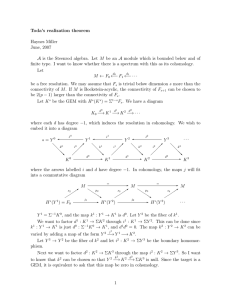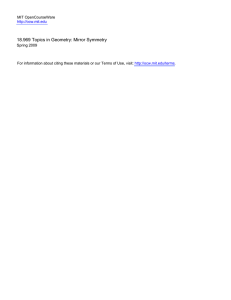30 Lecture
advertisement

Lecture 30 Lemma. d, dC anti-commute Proof. Write d = ∂ + ∂, where ∂ : Ωp,q → Ωp+1,q , ∂ : Ωp,q → Ωp,q+1 . Now, dC = J −1 dJ = J −1 ∂J + J −1 ∂J. Take α ∈ Ωp,q then J −1 ∂Jα = ip−q J −1 ∂α = − J −1 ∂Jα = ip−q ip−(q+1) ip−q ip+1−q ∂α = −i∂α ∂α = i∂α So dC = −i(∂ − ∂), so dC , d anti-commute because ∂ + ∂ and ∂ = ∂ anti-commute. Now, some more Hodge Theory. Take the identity dC = [δ, L] and decompose into its homogeneous components, by using dC = −i(∂ − ∂). t t Then ∂ t : Ωp,q → Ωp−1,q , ∂ : Ωp,q → Ωp,q−1 then δ = dt = ∂ t + ∂ . So dC = [δ, L] because t −i(∂ − ∂) = [∂ t , L] + [∂ , L] and by matching degrees we get t − ∂ = [∂ , L] i∂ = [∂ t , L] We’ll play around with these identities for a little while. 2 t t t We already know that ∂ 2 = ∂ = ∂∂ + ∂∂ = 0. And so (∂ t )2 = (∂ )2 = ∂ ∂ t + ∂ t ∂ = 0. Bracket these with L and we get 0 = [(∂ t )2 , L] = [∂ t , L]∂ t + ∂ t [∂ t , L] = i∂∂ t + ∂ t (i∂) so ∂∂ t + ∂ t ∂ = 0 t Similarly, from 0 = [(∂ )2 , L] we get t t ∂ ∂ + ∂∂ = 0 Lemma. The above identities imply the following Δ = Δ∂ + Δ∂ Proof. Δ = ddt + dt d t t = (∂ + ∂)(∂ t + ∂ ) + (∂ t + ∂ )(∂ + ∂) t t = Δ∂ + Δ∂ + (∂∂ t + ∂∂ ) + (∂ t ∂ + ∂ ∂) t t Now since ∂ t ∂ + ∂ ∂ t = 0 and we get t t 0 = [∂ ∂ t + ∂ t ∂ , L] t t = [∂ t ∂ , L] + [∂ ∂ t , L] t t t t = ∂ t [∂ , L] + [∂ t , L]∂ + ∂ [∂ t , L] + [∂ , L]∂ t t t t = −i(∂ t ∂ − ∂∂ ) − i(∂∂ t − ∂ ∂) t And we get ∂ t ∂ + ∂∂ t − ∂ ∂ − ∂∂ = 0, i.e. But since Δ = Δ∂ + Δ∂ , Δ∂ = Δ∂ = 12 Δ. Δ∂ − Δ∂ = 0 “This has some really neat applications” Neat Applications Δ∂ is the Laplace operator for the ∂ complex Ω1,0 ∂ � Ωi,1 ∂ � ... so it maps Ωi,j to Ωi,j which implies Δ : Ωi,j → Ωi,j . So Hk = ker Δ : Ωk → Ωk is a direct such � Hk = Hi,j i+j=k where Hi,j = Hk ∩ Ωi,j . We get a similar decomposition in cohomology � H k (X, C) = H i,j (X) = Im Hi,j i+j=k i,j i,j i,j where H = ker Δ∂ : Ω → Ω , so H � i,j So H k (X, C) = H∂ (X). i,j is the jth harmonic space for the Dolbeault complex.








